This Classic Sourdough Bread for all Seasons and Flours can be made with different types of flours, and baked as a soft crust sourdough sandwich loaf in a loaf pan, or freeform, to please picky kids or adults.
However, if you prefer a chewy crust, just bake it freeform on the baking stone at a higher temperature and reduce the bake time.
A few weeks ago, one of the bakers in the Artisan Bread Bakers FB group shared her recipe for a kid-friendly sourdough with a soft crust. It sounded like a wonderful recipe.
So I set out to make her white sourdough sandwich bread. However, somewhere along the way, I got the inspiration to try the formula using three different types of flours. It turned out to be a fun and rewarding experiment.
I made three different loaves: one using regular all-purpose flour, another using all-purpose Spelt flour and the other using white KAMUT flour. I followed the same formula but made slight adjustments to the hydration due to the absorption characteristics of each flour.
Each loaf is shaped into a batard shape, but scored differently. Each loaf is unique in flavor and texture due to the characteristics of the different types of flour and the scoring method used.
Classic Sourdough Bread for all Seasons
Adapted from Kid Friendly Soft Crust Sourdough by Nancy Winkelmann
Makes: 1 Loaf
Leaven: This bread uses a 166% hydration starter. Refresh the starter as follows:
In the evening combine:
| All-purpose or Bread Flour | Spelt Flour | KAMUT Flour |
| 1/8 cup starter | 1/8 cup Spelt starter | 1/8 cup KAMUT starter |
| 7/8 cup water | 3/4 cup water | 1 cup water |
| 7/8 cup AP or Bread flour | 7/8 cup Spelt flour | 7/8 cup KAMUT flour |
| 1/2 tablespoon rye flour | 1/2 tablespoon rye flour | 1/2 tablespoon rye flour |
Cover and leave the leaven at room temperature until it is bubbly, active, and passes the float test (8-12 hours).
It took my all-purpose and Spelt leavens about 14-16 hours to ripen, but it only took the KAMUT leaven 8 hours. I fed all of the starters before I began this process, but the all-purpose and Spelt starters hadn’t been fed for a few weeks before being fed. The KAMUT starter had been fed and used recently so the leaven ripened much quicker.
Formula:
260g refreshed starter (all of above)
108g water (75F) *
88g milk (75F) *
15g honey
8g coconut oil, melted (or vegetable oil)
1 small egg, beaten
465g flour (Bread flour, AP flour, all-purpose Spelt, or white KAMUT)
15g sea salt (after autolyse)
* I used the same amount of liquid in the final dough for each version.
Water absorption of the three different flours compared to bread flour:
- All-purpose flour: The original formula utilizes bread flour. I used all-purpose flour so I had to add a little more flour during mixing to keep it from being too sticky. I used the same amount of water in the levain as you would for bread flour.
- Spelt flour: Spelt doesn’t absorb water as well as bread flour so I reduced the amount of liquid in the levain and added a bit more flour to the final dough.
- KAMUT flour: KAMUT absorbs water better than bread flour so I increased the amount of water in the levain and reduced the amount of flour used in the final dough by 30g.
Mix and Autolyse
: Measure your starter into a large bowl, and set aside. In a separate bowl, combine all the wet ingredients (water, milk, honey, coconut oil, and egg). Pour wet ingredients into starter, and stir to combine. Add flour to the wet mixture, and stir or mix until no dry bits remain. Cover bowl and autolyse for 20 minutes.
After autolyse, add salt, and work into dough using pinch/stretch/fold (if mixing by hand), or by mixer. If using a mixer, mix about 2 minutes. If kneading by hand, turn out onto surface and knead, stretch/fold until smooth (about 5 minutes). Dough is easy to work with, and not overly sticky.
Bulk Ferment: Place dough in a large oiled bowl, cover and bulk ferment about 4 hours, performing 2 stretch/folds during the first 90 minutes. Dough will increase by more than half, and become pillowy.
Turn out dough onto lightly floured surface, shape into a rough round and bench rest 10 minutes.
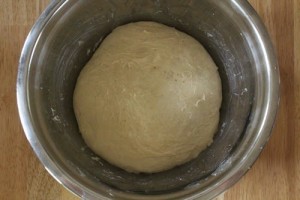 |
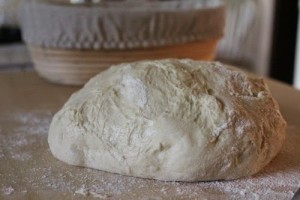 |
Shaping:
Shape dough gently without degassing. These loaves do really well shaped in the batard shape. Or you can shape them into a regular loaf shape and bake in a loaf pan. See variation at the bottom of the post for directions.
Place the loaf seam side up in flour-dusted, linen-lined basket or banneton.
Final Proof: This loaf can be baked the same day, or retarded overnight in the fridge. (You can do this for up to 2 days and still got good results). If you are making two loaves instead of one, you can stagger your baking over two days, rather than baking two loaves at once.
I baked the Spelt loaf the same day, but retarded the all-purpose and the KAMUT loaves overnight. I got good oven spring with all three loaves.
If baking the same day, continue to prove dough (covered) at room temperature for an additional 2-3 hrs. If retarding, this can be baked directly from the fridge, or proofed on the counter for 30-60 minutes.
Preheat oven to 400F with baking stone (at least 30 minutes). Sprinkle semolina on your peel or place the proofed loaf on parchment paper. If you aren’t using parchment paper, a little flour on the bottom of your loaf helps prevent the dough from sticking to the peel, and lets it slide right onto the baking stone cleanly.
Score Loaf: Invert loaf onto parchment paper and score. As I mentioned, I tried three different scoring methods. I used 3 slashes on the Spelt loaf (first loaf below). I slashed the all-purpose flour-loaf directly down the center (middle photos) and added some slashes along the sides. For the KAMUT loaf (third set of photos below), I used a zig zag scoring method using a straight-edge lame. Each scoring method produced a unique loaf.
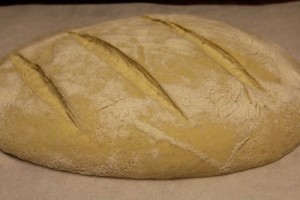 |
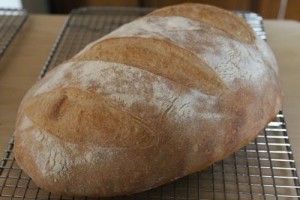 |
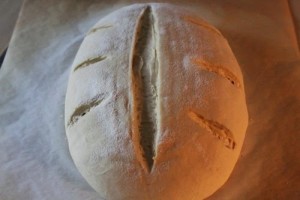 |
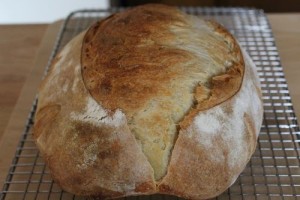 |
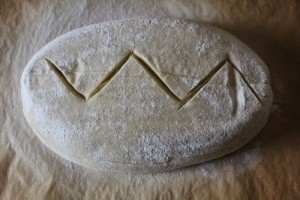 |
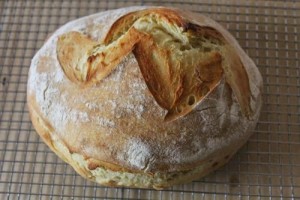 |
Baking: Slide the loaf (on the parchment paper) onto the preheated baking stone, spritz with water (using a spray bottle), and immediately close the door. Bake 20 minutes.
You can cover the loaf with a roasting pan during the first 20 minutes, then remove and follow the directions below. I didn’t use a roasting pan. I just baked the loaf uncovered on the baking stone the entire time. It didn’t take my loaf 40 minutes to bake so adjust the time accordingly.
After 20 minutes, reduce oven to 350F. Bake an additional 20-25 minutes, rotating once for even browning. The bread will have a pale blonde crust.
Cool completely on wire rack. Store bread in plastic bag for soft crust.
Variation: This bread can also be made in loaf pans. Bake uncovered (in the loaf pan without the baking stone) at 350F for 40 minutes. After baking, brush top of hot loaf with butter, if desired.
Thanks to Nancy for sharing her recipe for this wonderful soft crust sourdough.
Happy Baking!
Cathy
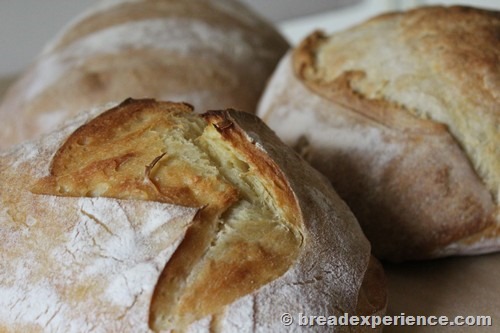
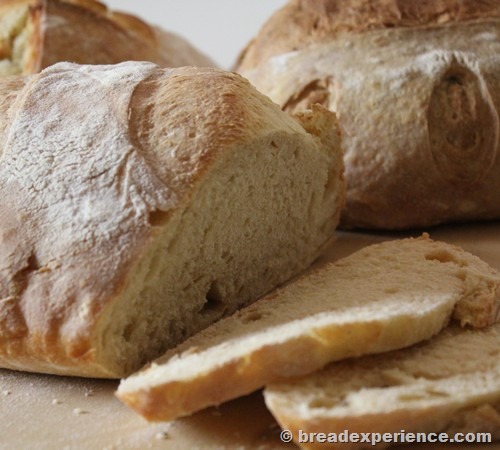
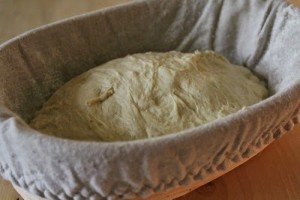
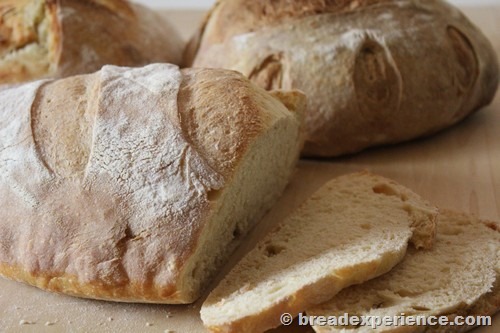
Leave a Reply